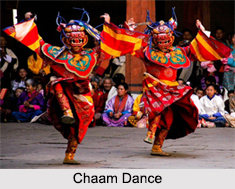 haam Dance is a vibrant masked and costumed dance ritual associated with some sects of Tibetan Buddhism and Buddhist festivals in Sikkim. This dance is performed on the eve of Losar, the Tibetan New Year. The dance is accompanied by music played by monks using traditional Tibetan musical instruments. This dance is considered as a form of meditation and an offering to the Gods. It is a dance symbolising the victory of good over evil.
haam Dance is a vibrant masked and costumed dance ritual associated with some sects of Tibetan Buddhism and Buddhist festivals in Sikkim. This dance is performed on the eve of Losar, the Tibetan New Year. The dance is accompanied by music played by monks using traditional Tibetan musical instruments. This dance is considered as a form of meditation and an offering to the Gods. It is a dance symbolising the victory of good over evil.
The dance ritual of Chaam is till date practiced in Himalayas, especially in places where Tibetan Buddhism prospered like Ladakh, Dharamshala, Lahaul Valley, Spiti Valley and Sikkim. The dance is the highlight of Buddhist festivals and special events of the monasteries. It is believed that simply witnessing the dance as an audience is said to bring one closer to enlightenment.
Origin of Chaam Dance
Chaam Dance is said to have first originated in the Himalayan Range and so is till date kept as a treasured secret in the lap of the mountains. According to a legend, the Chaam dance tradition was started by Guru Padmasambhava in the late 8th CE. When the king of Tibet, Trishong Detsen called Guru Padmasambhava to get rid of evil spirits that did not allow building the Samye Monastery, the revered Guru performed the dance ritual. The same ritual over the period of time became the elaborate Chaam Dance, a practice specific to the sect of Mahayana Buddhism.
Performance of Chaam Dance
Chaam Dance often depicts incidents from the life of Guru Padmasambhava, the 9th century Nyingma teacher and other saints. The monks who perform this dance have to meditate for days or even weeks beforehand, visualising and invoking protective deities. On the day of performances, the monks visualise themselves as deities, they perform ancient movement by chanting sacred mantras. It is believed that they draw in the evil in the crowd and the surrounding world. The evil is trapped in an effigy or a human body made of dough. Then the dance master cuts open the effigy and draw the evil into his body to show it peace and the path to liberation. The monks performing Chaam Dance are dressed in highly ornamented costumes of brightly coloured silk and wear elaborate mask. The mask represents various deities and demons, as well as animals.



















